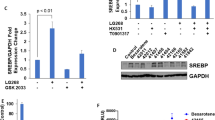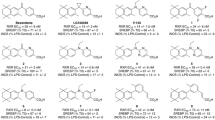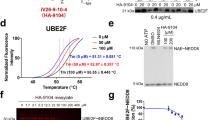Abstract
Lung cancer causes more than 140,000 deaths annually in the United States alone, and the prognosis for non-small cell lung cancer (NSCLC) is particularly poor1. Therapies using small molecules that preferentially kill lung tumor cells by inducing cellular suicide (apoptosis) would therefore be highly desirable. Retinoids have shown promise as cancer preventive and cancer therapeutic agents2–5. Retinoid signals are mediated by two classes of nuclear receptors: the retinoic acid receptors (RARα, β, and γ) and the retinoid X receptors (RXRα, β and γ)5–8. These receptors usually bind as heterodimers to specific DNA sequences9 and/or interact with other transcriptional regulators, such as AP-1 (ref. 10) to regulate gene transcription. Synthetic retinoids can be made that activate only specific portions of the complex retinoid response network11–15 and activate selective biological programs. To identify retinoids with novel biological activities, we used a high-throughput “biological activity fingerprint” screen on a large library of retinoids and retinoid-related molecules (RRMs). We identified new structures that are highly effective against lung cancer cells in vitro, inducing apoptosis. We show here for one of these compounds that it is very effective against a human NSCLC in vivo in an animal model. These new molecules show a distinct pattern of receptor signaling.
This is a preview of subscription content, access via your institution
Access options
Subscribe to this journal
Receive 12 print issues and online access
$209.00 per year
only $17.42 per issue
Buy this article
- Purchase on Springer Link
- Instant access to full article PDF
Prices may be subject to local taxes which are calculated during checkout
Similar content being viewed by others
References
Ginsberg, R.J., Kris, M.G. & Armstrong, J.G. Non-small cell lung cancer. in Cancer: Principles & Practice of Oncology, 4th edn., Vol. 1. (ed. DeVita, V.T., Jr., Hellman, S. & Rosenberg, S.A.). 673–713 (Lippicnott, Philadelphia, 1993).
Hong, W.K. et al. Prevention of second primary tumors with isotretinoin in squamous-cell carcinoma of the head and neck. N. Engl. J. Med. 323, 795–801 (1991).
Huang, M.-E. et al. Use of all-trans -retinoic acid in the treatment of acute promyelocytic leukemia. Blood 72, 567–572 (1988).
Castaigne, S. et al. All-trans-retinoic acid as a differentiation therapy for acute promyelocytic leukemia. Blood 76, 1704–1709 (1990).
Pfahl, M. Retinoids: Concepts for separation of desirable and undesirable effects in the treatment or prevention of cancer. in Hormones and Cancer. (ed. Vedeckis, W.V.) 127–146 (Birkhauser, Boston, MA, 1996).
Chambon, P. The retinoid signaling pathway: molecular and genetic analyses. Semin. Cell Biol. 5, 115–125 (1994).
Managelsdorf, D.J. et al. The nuclear receptor superfamily: The second decade. Cell 83, 835–839 (1995).
Pfahl, M. et al. Nuclear retinoid receptors and their mechanisms of action. in Vitamins and Hormones, Vol. 49 (ed. G. Litwac) 327–382 (Academic Press, San Diego, CA, 1994).
La Vista-Picard, N., Hobbs, P.D., Pfahl, M., Dawson, M.I. & Pfahl, M. The receptor-DNA complex determines the retinoid response: A mechanism for the diversification of the ligand signal. Mol. Cell. Biol. 16, 4137–4146 (1996).
Pfahl, M. Nuclear receptor/AP-1 interaction. Endocr. Rev. 5, 651–658 (1993).
Lehmann, J.M., Dawson, M.I., Hobbs, P.D., Husmann, M. & Pfahl, M. Identification of retinoids with nuclear receptor subtype selective activities. Cancer Res. 52, 4804–4809 (1991).
Graupner, G. & Pfahl, M. 6′-Substituted naphthalene-2-carboxylic acid analogs, a new class of retinoic acid receptor subtype-specific ligands: A selection by transcriptional activation assay. Biochem. Biophys. Res. Commun. 179, 1554–1561 (1991).
Delescluse, C. et al. Selective high affinity retinoic acid receptor α or β-γ ligands. Mol. Pharmacol. 40, 556–562 (1991).
Funjul, A. et al. A novel class of retinoids with selective anti-AP-1 activity exhibit anti-proliferative activity. Nature 372, 107–111 (1994).
Lehmann, J.M. et al. Retinoids selective for retinoid X receptor response pathways. Science. 258, 1944–1946 (1992).
Weinstein, J.N. et al. An information-intensive approach to the molecular pharmacology of cancer. Science 275, 343–349 (1997).
Lotan, R. Suppression of squamous cell carcinoma growth and differentiation by retinoids. Cancer Res. 54, 1987–1990 (1994).
Martin, S.J. & Green, D.R. Protease activation during apoptosis: Death by a thousand cuts? Cell 82, 349–352 (1995).
Lowe, S.W., Ruley, H.E., Jacks, T. & Housman, D.E. p53-dependent apoptosis modulates the cytoxicity of anticancer agents. Cell 74, 957–967 1993).
Funjul, A.N. et al. 4-Hydroxyphenyl retinamide is a highly selective activator of retinoid receptors. J. Biol. Chem. 271, 22441–22446 (1996).
Delia, D. et al. Regulation of apoptosis induced by the retinoid N-(4-hydroxyphenyl) retinamide and effect of deregulated bcl-2. Blood 85, 359–367 (1995).
Benbrook, D., Lernhardt, W. & Pfahl, M. A new retinoic acid receptor identified from a hepatocellular carcinoma. Nature 333, 669–672 (1988).
Lowe, S.W., Schmitt, E.M., Smith, S.W., Osborne, B.A. & Jacks, T. p53 is required for radiation-induced apoptosis in mouse thymocytes. Nature 362, 847–849 (1993).
Shroot, B., Eustache, J. & Bernardon, J.-M. Benzimidazole derivatives and their therapeutic and cosmetic use. US Patent 4920140 (1990).
Author information
Authors and Affiliations
Rights and permissions
About this article
Cite this article
Lu, XP., Fanjul, A., Picard, N. et al. Novel retinoid-related molecules as apoptosis inducers and effectve inhibitors of human lung cancer cells in vivo. Nat Med 3, 686–690 (1997). https://doi.org/10.1038/nm0697-686
Received:
Accepted:
Issue Date:
DOI: https://doi.org/10.1038/nm0697-686
This article is cited by
-
All-trans-retinoic acid induces apoptosis in Leydig cells via activation of the mitochondrial death pathway and antioxidant enzyme regulation
Journal of Bioenergetics and Biomembranes (2008)
-
Antimyeloma effects of a novel synthetic retinoid Am80 (Tamibarotene) through inhibition of angiogenesis
Leukemia (2005)
-
Induction of apoptosis by the synthetic retinoid MX3350-1 through extrinsic and intrinsic pathways in head and neck squamous carcinoma cells
Oncogene (2005)
-
Retinoid-related molecules require caspase 9 for the effective release of Smac and the rapid induction of apoptosis
Cell Death & Differentiation (2004)
-
Retinoid targets for apoptosis induction
Oncogene (2003)



